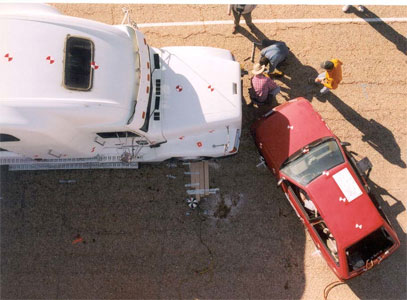GMH Engineering
GMH Engineering was conceived by three friends who shared graduate student office space in the advanced thermodynamics lab at Brigham Young University (BYU). J. Gordon, Chuck Monson and Greg Heiner also shared a passion for the many facets of engineering and for the creative, hands-on processes of designing, building, testing, and analyzing machines. In January of 1988 the three fledgling engineers borrowed a bit of seed money from two of their fathers (one dad considered it a poor investment!), formed a partnership and launched GMH Engineering. The company was incorporated a few months later. From the start GMH Engineering has been deeply involved in instrumentation, data acquisition, testing, and analysis. The three founding partners are hands-on engineers who have a natural feel for machines. J and Greg supported their families during their university studies working as automobile mechanics. Chuck has been restoring vintage cars since he was 16 and worked professionally as a welder.
Chuck’s PhD project included the design, fabrication and use of a coal char reactor operated at temperatures of 2600 °F, pressures of 400 psi and included unique optical instrumentation that measured the size, velocity and temperature of micron-sized, combusting char particles. This research significantly advanced the understanding and modeling of char oxidation at elevated pressures. During the same period of time, Chuck also assisted in the development of specialized Anthropomorphic Test Dummy (ATD) heads that were used to advance the knowledge and understanding of human facial injuries in automotive impacts. His work focused on the design, fabrication, testing, and refinement of the prototype and production ATD heads. As a result of interest generated by this published research, GMH Engineering manufactured and sold production versions of the specialized ATD heads and associated instrumentation to major automobile manufacturers worldwide.
During the period when Chuck was working on the ATD heads, Greg was involved in the numerical modeling associated with that same research. This was in the days when numerical modeling was a very hands-on process involving many hundreds of lines of FORTRAN code. Greg’s master’s thesis involved developing a comprehensive numerical model of a spark ignition internal combustion engine. This proprietary computer program included a FORTRAN graphics library that was spun-off as one of GMH Engineering’s successful early products.
For J’s university senior project he designed and built a self-contained, computer-controlled winch used to pull test vehicles into the crash zone for full-scale automotive crash testing. The winch incorporated a Chrysler 440ci V8 engine and transmission, both modified to be directly controlled by a custom-designed computer control system. This winch is still in use more than 25 years later.
Given the backgrounds and early experiences of its founders, GMH Engineering became heavily involved in automotive crash testing and safety research. A need was soon recognized for an economical, crashworthy, onboard data acquisition system. The data acquisition technology of the time included a data logger track side, connected to onboard instrumentation through an electrical umbilical cable dragging on the ground. To solve the physical and electrical problems associated with dragging a lengthy umbilical cable, the DataBRICK was conceived and developed. Today, GMH Engineering is selling the third generation of this proven data acquisition system.
In the early 1990’s GMH Engineering was retained to investigate an incident at a local amusement park - beginning a nearly two-decade involvement in testing and analyzing amusement ride dynamics. As before, GMH Engineering found the technology of the day lacking. In order to improve the utility of the three-dimensional acceleration data acquired in testing roller coasters, GMH Engineering developed a methodology to correlate the acquired acceleration data to the position of the train along the ride’s track. This development encompassed signal processing algorithms and instrumentation hardware, including the development of the DRS1000 Non-contact Speed Sensor - GMH Engineering’s best selling product.
This abbreviated early history demonstrates the focus GMH Engineering has had from its inception – to apply creativity, ingenuity and hands-on engineering expertise in solving technical challenges for which there were no suitable, off-the-shelf solutions. Over the years, GMH Engineering has applied this focus and the synergistic talents of its founders in developing world-class expertise in the fields of:
• Instrumentation & Data Acquisition |
• Ride Quality Testing & Analysis |
• Amusement Ride Testing & Analysis |
• Whole Body Vibration Testing & Analysis |
• Forensic Engineering & Analysis |
• Hand-Arm Vibration Testing & Analysis |
• Electronic & Mechanical Product Development |
• Computer Software Development |
• Automotive & Railroad Crash Testing, Crashworthiness & Safety Research |
|
To facilitate its work, GMH Engineering has developed unique facilities including an electronics development laboratory, an instrumentation production facility, a mechanical fabrication and machine shop, an inventory of instrumentation and test equipment, and a full-scale automotive crash test facility equipped for both vehicle-to-vehicle and barrier testing.
Much of GMH Engineering’s success can be attributed to the founding engineers' problem solving ingenuity and their ability to accomplish technically difficult testing. GMH Engineering excels at finding innovative solutions to difficult engineering problems. When other firms turn jobs down as too difficult, too expensive or impractical, GMH Engineering finds cost-effective solutions. If you have an engineering problem to be solved, a machine to be instrumented, tested and analyzed, or a frustrating instrumentation or data acquisition issue for which there seems to be no off-the-shelf solution, contact GMH Engineering. We can help.
